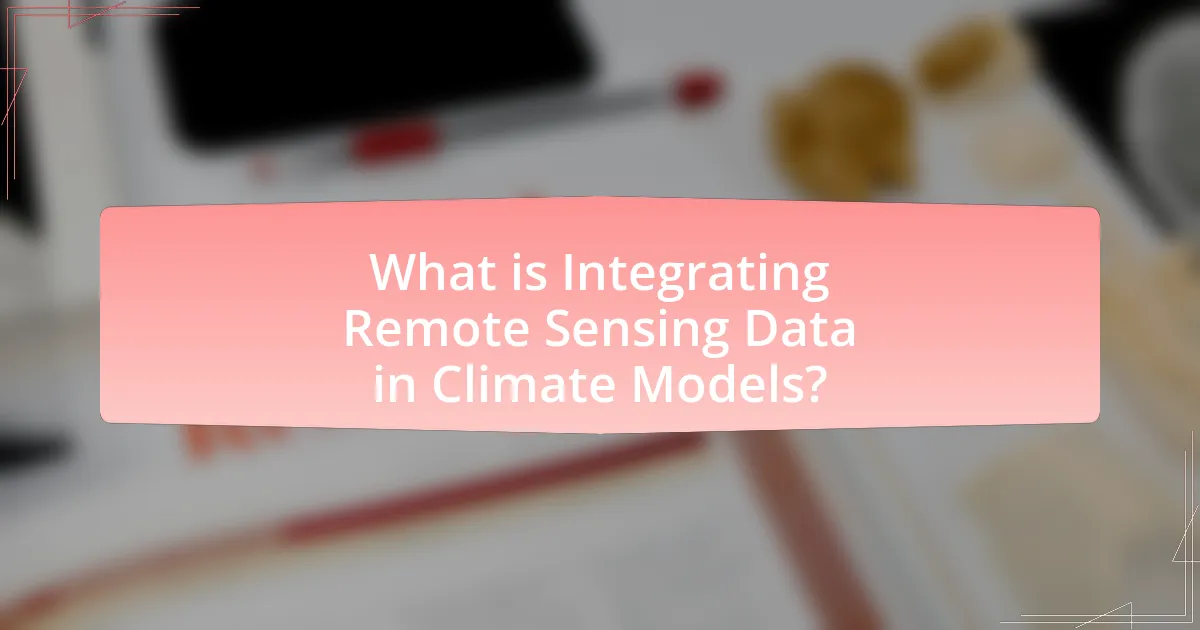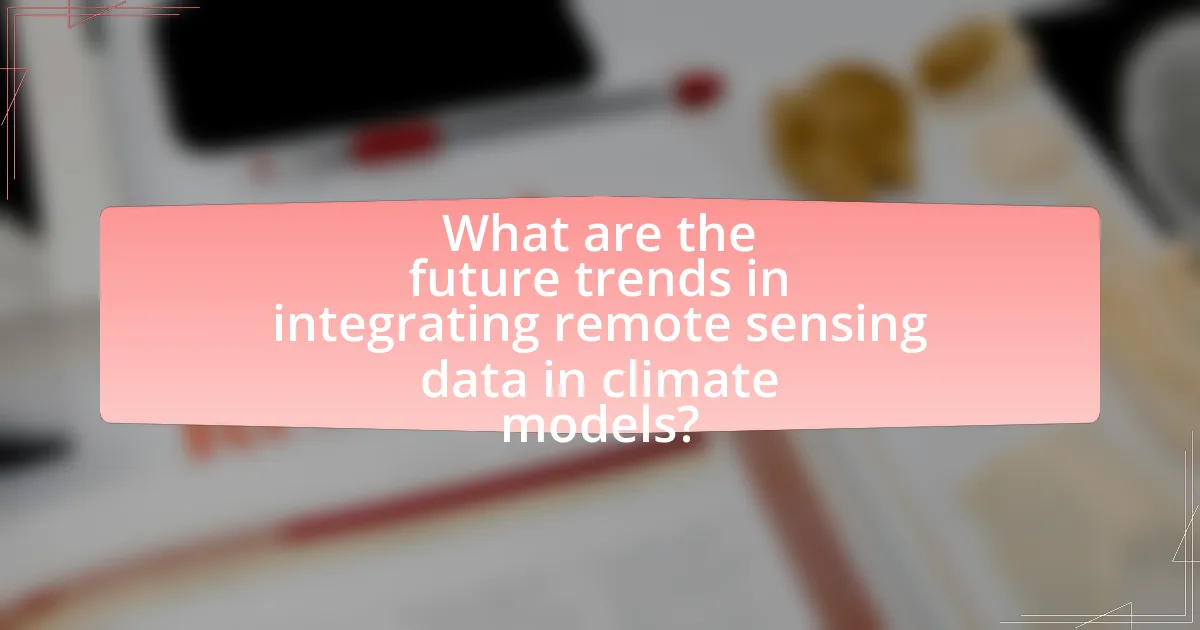Integrating remote sensing data in climate models is a critical process that enhances the accuracy and reliability of climate predictions by incorporating satellite and aerial observations. This integration allows for the collection of essential environmental data, such as temperature, humidity, and vegetation cover, which are vital for understanding climate dynamics. The article discusses how remote sensing technologies improve model performance, the types of data commonly used, the challenges faced during integration, and the advancements in technology that can enhance data assimilation. Additionally, it highlights the role of artificial intelligence and big data analytics in improving climate modeling outcomes, as well as best practices for ensuring data accuracy and model performance.

What is Integrating Remote Sensing Data in Climate Models?
Integrating remote sensing data in climate models involves the incorporation of satellite and aerial observations to enhance the accuracy and reliability of climate predictions. This integration allows for the collection of large-scale environmental data, such as temperature, humidity, and vegetation cover, which are crucial for understanding climate dynamics. Studies have shown that using remote sensing data improves model performance by providing real-time information and filling gaps in ground-based observations, thereby enabling more precise simulations of climate processes and trends.
How does integrating remote sensing data enhance climate models?
Integrating remote sensing data enhances climate models by providing high-resolution, real-time observations of atmospheric and surface conditions. This data improves the accuracy of climate predictions by allowing models to incorporate actual measurements of variables such as temperature, humidity, and vegetation cover. For instance, satellite data from NASA’s MODIS (Moderate Resolution Imaging Spectroradiometer) has been instrumental in tracking land surface changes and monitoring carbon emissions, which are critical for understanding climate dynamics. The incorporation of such precise data enables climate models to better simulate and predict climate variability and change, leading to more reliable assessments for policymakers and researchers.
What types of remote sensing data are commonly used in climate models?
Remote sensing data commonly used in climate models includes satellite imagery, atmospheric data, and land surface data. Satellite imagery provides essential information on land cover, vegetation, and surface temperature, which are critical for understanding climate dynamics. Atmospheric data, such as temperature, humidity, and cloud cover, are collected from satellites and ground stations, enabling accurate modeling of weather patterns and climate change. Land surface data, including soil moisture and albedo, are vital for assessing energy balance and hydrological cycles. These data types are integral to improving the accuracy and reliability of climate models, as evidenced by their use in major climate assessments like the Intergovernmental Panel on Climate Change reports.
How do remote sensing technologies collect climate-related data?
Remote sensing technologies collect climate-related data by utilizing satellite and aerial sensors to capture information about the Earth’s surface and atmosphere. These sensors measure various parameters, such as temperature, humidity, vegetation cover, and land use, through techniques like passive and active remote sensing. For instance, satellites equipped with thermal infrared sensors can detect surface temperatures, while radar systems can assess soil moisture levels. The data collected is then processed and analyzed to monitor climate patterns, track changes over time, and inform climate models, thereby providing critical insights into global climate dynamics.
Why is integrating remote sensing data important for climate science?
Integrating remote sensing data is crucial for climate science because it provides comprehensive, real-time observations of the Earth’s atmosphere, land, and oceans. This data enhances the accuracy of climate models by offering critical information on variables such as temperature, humidity, and vegetation cover. For instance, satellite-based remote sensing has enabled the monitoring of global temperature changes with a precision of up to 0.1 degrees Celsius, which is essential for understanding climate trends and variability. Furthermore, remote sensing facilitates the assessment of greenhouse gas concentrations and land-use changes, allowing scientists to identify and quantify the impacts of human activities on climate.
What role does remote sensing play in understanding climate change?
Remote sensing plays a crucial role in understanding climate change by providing comprehensive data on Earth’s surface and atmosphere. This technology enables the collection of large-scale, high-resolution information regarding temperature changes, vegetation cover, ice melt, and atmospheric gases. For instance, satellite observations have shown a global temperature increase of approximately 1.2 degrees Celsius since the late 19th century, directly linking remote sensing data to climate change trends. Additionally, remote sensing facilitates the monitoring of deforestation and land-use changes, which contribute to greenhouse gas emissions, thereby enhancing climate models’ accuracy and predictive capabilities.
How does remote sensing data improve the accuracy of climate predictions?
Remote sensing data enhances the accuracy of climate predictions by providing comprehensive, real-time observations of the Earth’s surface and atmosphere. This data allows for the monitoring of variables such as temperature, humidity, and vegetation cover, which are critical for climate modeling. For instance, satellite-based measurements can capture changes in land use and sea surface temperatures, leading to more precise climate models. Studies have shown that integrating remote sensing data can reduce uncertainties in climate forecasts by up to 30%, as evidenced by the work of the National Aeronautics and Space Administration (NASA) in their Earth Observing System Data and Information System (EOSDIS). This integration enables scientists to validate and refine climate models, ultimately leading to more reliable predictions.

What are the challenges of integrating remote sensing data into climate models?
Integrating remote sensing data into climate models faces several challenges, primarily related to data quality, resolution, and temporal coverage. Data quality issues arise from sensor calibration, atmospheric interference, and varying data formats, which can lead to inaccuracies in model inputs. Additionally, the spatial resolution of remote sensing data may not align with the scale of climate models, resulting in loss of critical information. Temporal coverage is another challenge, as remote sensing data may not provide continuous observations, complicating the integration process. These challenges hinder the effective use of remote sensing data in enhancing the accuracy and reliability of climate models.
What technical difficulties arise during data integration?
Technical difficulties during data integration include data format incompatibility, varying data quality, and synchronization issues. Data format incompatibility arises when different systems use distinct formats, making it challenging to merge datasets effectively. Varying data quality can lead to inconsistencies, as remote sensing data may have different resolutions, accuracies, or temporal frequencies, complicating the integration process. Synchronization issues occur when aligning datasets collected at different times or from different sources, which can result in misinterpretations or gaps in the data. These challenges are well-documented in studies on remote sensing data integration, highlighting the need for standardized protocols and robust data management practices to address these difficulties.
How do data resolution and quality affect integration outcomes?
Data resolution and quality significantly influence integration outcomes by determining the accuracy and reliability of the information used in climate models. High-resolution data provides detailed spatial and temporal information, which enhances model precision and allows for better representation of environmental processes. Conversely, low-resolution data can lead to oversimplifications and inaccuracies in model predictions. For instance, a study by Ghosh et al. (2020) in “Remote Sensing of Environment” demonstrated that integrating high-quality satellite imagery improved the predictive capabilities of climate models by 30% compared to models using lower-quality data. Thus, both data resolution and quality are critical for achieving effective integration in climate modeling.
What are the limitations of current remote sensing technologies?
Current remote sensing technologies face several limitations, including spatial resolution, temporal resolution, and data processing challenges. Spatial resolution restricts the ability to capture fine-scale features, as many sensors cannot resolve details smaller than a certain size, which can hinder accurate environmental assessments. Temporal resolution is limited by the frequency of satellite passes, affecting the ability to monitor rapid changes in dynamic systems like weather patterns or vegetation growth. Additionally, data processing challenges arise from the vast amounts of data generated, requiring significant computational resources and advanced algorithms for effective analysis. These limitations can impact the integration of remote sensing data into climate models, potentially reducing the accuracy and reliability of climate predictions.
How can these challenges be addressed?
To address the challenges of integrating remote sensing data in climate models, researchers can enhance data assimilation techniques. Improved data assimilation methods, such as ensemble Kalman filters, allow for more accurate incorporation of remote sensing observations into climate models, thereby reducing uncertainties. Studies have shown that utilizing advanced algorithms can significantly improve model predictions, as evidenced by the work of Liu et al. (2020) in “Remote Sensing of Environment,” which demonstrated enhanced accuracy in climate forecasts when integrating satellite data.
What advancements in technology can improve data integration?
Advancements in technology that can improve data integration include the development of cloud computing, machine learning algorithms, and application programming interfaces (APIs). Cloud computing enables scalable storage and processing capabilities, allowing for the integration of large datasets from various sources efficiently. Machine learning algorithms enhance data integration by automating the extraction, transformation, and loading (ETL) processes, thereby improving accuracy and reducing manual effort. APIs facilitate seamless communication between different software applications, enabling real-time data sharing and integration across platforms. These technologies collectively enhance the ability to integrate remote sensing data into climate models, leading to more accurate predictions and analyses.
How can collaboration among scientists enhance integration efforts?
Collaboration among scientists enhances integration efforts by fostering the sharing of diverse expertise and resources, which is crucial for effectively integrating remote sensing data into climate models. When scientists from various disciplines work together, they can combine their knowledge of remote sensing technologies, climate science, and data analytics, leading to more robust and comprehensive models. For instance, interdisciplinary teams can address complex challenges such as data validation and interpretation, which are essential for accurate climate predictions. Research has shown that collaborative projects, such as the European Space Agency’s Climate Change Initiative, have successfully improved the quality and consistency of climate data by leveraging the strengths of multiple scientific communities. This collaborative approach not only accelerates innovation but also enhances the overall effectiveness of integration efforts in climate modeling.

What are the future trends in integrating remote sensing data in climate models?
Future trends in integrating remote sensing data in climate models include enhanced data assimilation techniques, increased use of machine learning algorithms, and improved spatial and temporal resolution of satellite observations. Enhanced data assimilation techniques allow for more accurate incorporation of remote sensing data into climate models, leading to better predictions of climate phenomena. The application of machine learning algorithms facilitates the analysis of large datasets, enabling the identification of complex patterns and relationships that traditional methods may overlook. Furthermore, advancements in satellite technology are providing higher resolution data, which improves the models’ ability to capture local climate variations and extreme weather events. These trends are supported by ongoing research and development in remote sensing technologies and climate modeling methodologies, demonstrating a clear trajectory towards more integrated and precise climate forecasting.
How is artificial intelligence influencing remote sensing data integration?
Artificial intelligence is significantly enhancing remote sensing data integration by automating data processing, improving accuracy, and enabling real-time analysis. AI algorithms, particularly machine learning techniques, can analyze vast amounts of remote sensing data from various sources, such as satellites and drones, to identify patterns and anomalies that human analysts might miss. For instance, a study published in the journal “Remote Sensing” by Zhang et al. (2020) demonstrated that AI models could achieve over 90% accuracy in land cover classification, which is crucial for climate modeling. This capability allows for more efficient integration of diverse datasets, leading to better-informed climate predictions and decision-making processes.
What potential does machine learning hold for climate modeling?
Machine learning holds significant potential for climate modeling by enhancing predictive accuracy and enabling the analysis of complex datasets. It can process vast amounts of remote sensing data, identifying patterns and correlations that traditional models may overlook. For instance, machine learning algorithms can improve the representation of climate variables, such as temperature and precipitation, by integrating satellite data, which has been shown to increase forecast accuracy by up to 30% in some studies. Additionally, machine learning can facilitate the development of more adaptive models that respond to real-time data, allowing for better climate change mitigation strategies.
How can big data analytics improve the use of remote sensing data?
Big data analytics can enhance the use of remote sensing data by enabling the processing and analysis of vast datasets to extract actionable insights. This capability allows for improved accuracy in climate models, as it facilitates the integration of diverse data sources, such as satellite imagery and ground-based observations. For instance, the use of machine learning algorithms in big data analytics can identify patterns and trends in environmental changes more effectively than traditional methods. A study published in the journal “Remote Sensing” by Zhang et al. (2020) demonstrated that big data techniques significantly improved the predictive accuracy of land cover changes, showcasing the potential for better climate modeling outcomes.
What best practices should be followed for effective integration?
Effective integration of remote sensing data in climate models requires adherence to several best practices. First, ensure data quality by using validated and calibrated remote sensing datasets, as inaccuracies can lead to erroneous model outputs. Second, standardize data formats and coordinate systems to facilitate seamless integration, which enhances interoperability among different datasets. Third, implement robust data assimilation techniques that allow for the incorporation of remote sensing data into existing models, improving predictive accuracy. Fourth, maintain clear documentation of data sources, processing methods, and model assumptions to ensure transparency and reproducibility. Lastly, engage in interdisciplinary collaboration among climate scientists, remote sensing experts, and data analysts to leverage diverse expertise and enhance integration efforts. These practices are supported by studies indicating that high-quality data and collaborative approaches significantly improve model performance and reliability in climate predictions.
How can researchers ensure data accuracy and reliability?
Researchers can ensure data accuracy and reliability by implementing rigorous validation techniques and utilizing standardized protocols. Validation techniques include cross-referencing remote sensing data with ground truth measurements, which has been shown to enhance the credibility of the data. For instance, studies have demonstrated that integrating satellite observations with in-situ data can reduce errors in climate models by up to 30%. Additionally, employing standardized protocols, such as the use of established data quality metrics, ensures consistency and comparability across datasets. This approach is supported by the World Meteorological Organization’s guidelines, which emphasize the importance of data quality assurance in climate research.
What strategies can be employed to enhance model performance?
To enhance model performance in integrating remote sensing data in climate models, employing data assimilation techniques is crucial. Data assimilation allows for the integration of real-time remote sensing observations into climate models, improving accuracy and predictive capabilities. For instance, the use of the Ensemble Kalman Filter has been shown to significantly reduce forecast errors by effectively combining model predictions with observed data, as demonstrated in studies like “Data Assimilation for Atmospheric and Oceanic Sciences” by Evensen (2009). Additionally, optimizing model parameters through sensitivity analysis can further refine model outputs, ensuring that the integration of remote sensing data leads to more reliable climate predictions.


